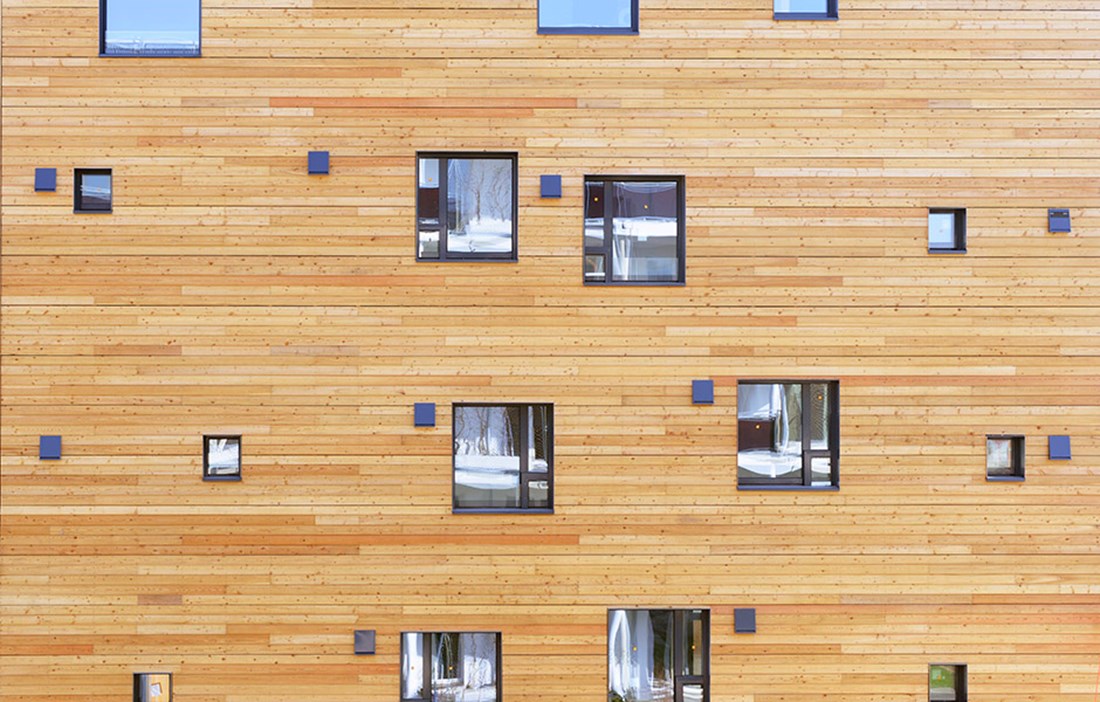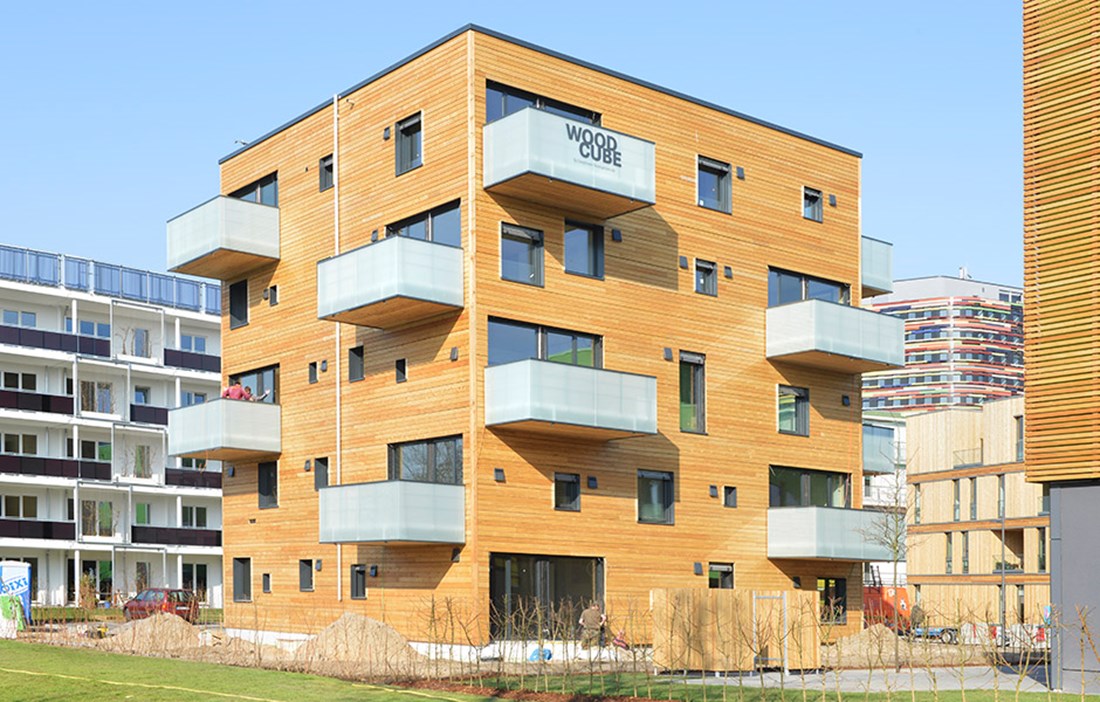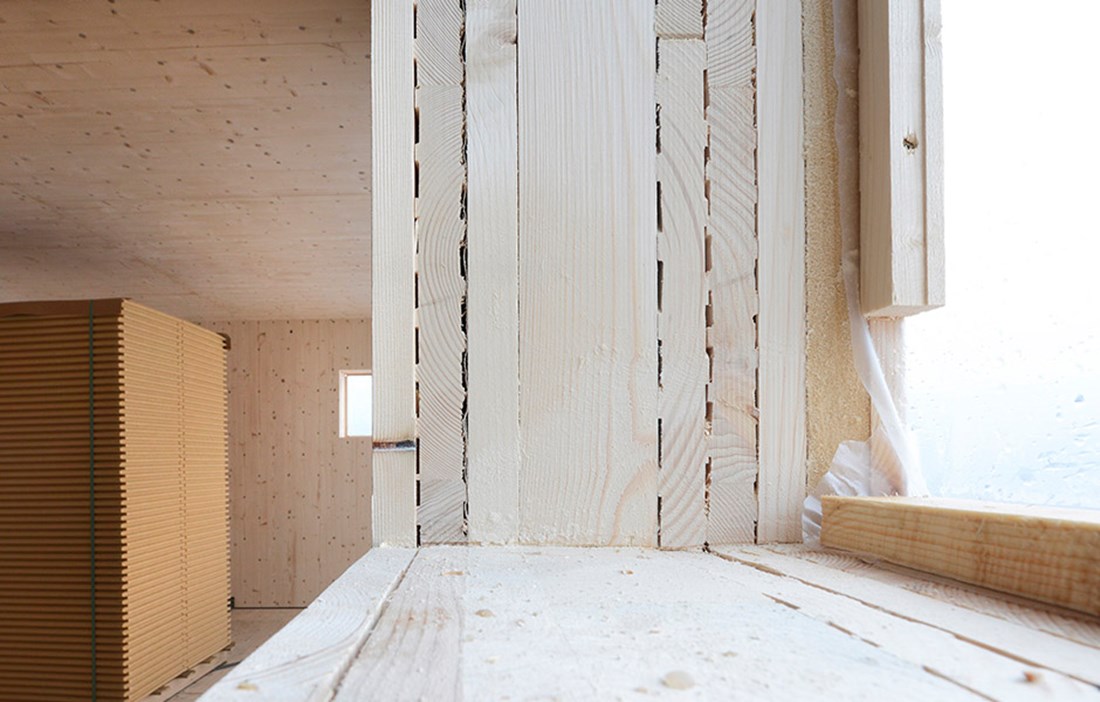THE FIVE-STOREY WOODCUBE is part of the international building exhibition IBA 2013 in Hamburg. However, it by no means blends in with the crowd: the wood facade stands in sharp contrast to the white rendered concept houses opposite. The building is, as the name suggests, a cube in wood with wide balconies that protrude asymmetrically from the walls. It may not be the only building in the exhibition with a wood facade, but it is certainly the only one whose walls are entirely made from timber.
“Being inside the Woodcube is like being inside a tree. The walls are all timber and the building is free from any plastics, glues or chemicals,” explains developer Matthias Korff.
There is considerable interest in the Woodcube and much of Matthias’s time since the exhibition opened has been spent showing inquisitive visitors around. But this is something he is more than happy to do, since the project is very close to his heart.
DEVELOPER MATTHIAS KORFF is the person who initiated, and stubbornly drove the project forward. He previously focused on redeveloping buildings such as old factories, hospitals or barracks and converting them into housing, which was certainly a profitable business. Since 1995 he has redeveloped over 4,000 sites across Germany, but during this work he has also been confronted with what is concealed within these buildings.
“The first stage of the redevelopment always involved people in full protective clothing spending six weeks removing all the toxins from the walls. Chemicals have no place in our homes and it was that realisation that prompted me to switch to natural newbuilds.”
Another contributing factor was a visit to the doctor, who informed him that he had quantities of toxins in his blood, all of which could be linked to his home environment. This got him thinking about how, as a developer, he actually built housing.
With Woodcube, his ambition has been to make use of wood’s positive environmental credentials and at the same time show that it is possible to build without using chemicals.
“We buy organic food, make sure our clothing is ethically manufactured and not full of chemicals, but no one talks about the way we live and all the toxins that can be found in the walls around us,” says Matthias, before he heads back into the Woodcube with a another group of interested visitors.
INSIDE THERE ARE eight apartments measuring between 80 and 190 m², all with at least one balcony. The internal walls, flooring and ceilings are all made entirely of wood. Despite the low-key, natural finishes, this is a high-tech building. Sensors measure the air in all the rooms and each electrical socket can be monitored and controlled using a smartphone.
The Woodcube was designed by the firm Architekturagentur, which specialises in energy efficient buildings. Oliver Hilt from the firm describes the building as an unusual project, calling it a prototype for new wood architecture.
“The planning was tricky, but we succeeded in building using untreated cross-laminated timber and showing that it is possible to build a timber building with structural beams measuring over five metres,” he reports.
The design can be varied in all sorts of ways, but here the unifying aesthetic feature is the square, something that runs throughout the building in everything from its cubic shape to the windows and openings. The design is also optimised down to the smallest detail, and each opening is perfectly positioned to create solid walls.
“Thanks to a lack of any load-bearing internal walls, we were able to be flexible in designing the eight apartments. No two apartments are the same and they can easily be changed at a later date,” says Oliver Hilt.
One of the rooms houses an enormous block of cross-laminated spruce. The block was cut out of the wall to reveal the secret behind how the Woodcube could be built without insulation or chemicals. All the layers of wood combine to form a 30 cm thick wall that, in contrast to regular CLT or glulam, is held together with beech plugs.
“We didn’t want to use glue, because that contains chemicals and stops the wood from breathing. The plugs are dried down to only 5% moisture content and are sprayed with a mix of water, lime and quark before being tapped in. Since wood normally has a moisture content of around 15%, the plugs absorb water, swell and become one with the material,” says Matthias Korff, pointing at the rows of round plugs in the timber block.
The design is an evolution of the Holz100 concept, a technology developed by Austrian Erwin Thoma. It is all so simple, with 20 plugs per square metre holding together all the layers of wood in an entirely natural way.
THE WOODCUBE’S THICK walls keep damp and cold out naturally, while also providing effective fireproofing. Hamburg is a city built mainly in brick and the authorities therefore refused planning permission for a five-storey building made entirely in wood.
“The timber walls provide both insulation and fireproofing, but we are in Germany, and there are rules for everything. The regulations don’t tell you what to do with a 30 cm thick wall of wood. There were no guidelines, so I was forced to prove that it works,” states Matthias.
With the help of a German university in Darmstadt, Matthias tested the material at a cost of half a million euros. The results were exactly as he had expected and came to set a new standard for timber buildings in Germany.
“German fire regulations state that a wall must hold for at least 90 minutes. So we subjected our timber wall to 1000° and it held for over five hours because it’s so thick.”
The fire safety authorities were impressed by the results, but still demanded that the lift shaft should be built in concrete. This is, however, a decision that has since been reconsidered.
“Wood is a poor heat conductor so if I have 1000° on one side, the other side is nowhere near as hot. In Vienna, for example, they’re building a lift shaft entirely in wood for that very reason,” says Mattias.
The group of visitors tap the Woodcube’s thick walls of wood. The walls provide such good insulation that there is actually no need for any radiators. And despite such good insulating properties, the whole building is able to breathe, which creates a good indoor climate without the need for extra ventilation. This in turn saves even more energy, which is yet another positive feature of this wood-based design. Thanks to all this, the Woodcube has been classed as a passive house.
“We also have no plastic in the walls, because we want to keep them open. The walls take up moisture and then release it back in a wholly natural process. As long as there is fresh air, the wood dries out and nothing bad happens to it.”
AS WELL AS CREATING a building entirely free from chemicals, Matthias Korff also wanted the Woodcube’s environmental impact to be as small as possible. Choosing wood as the material has played a major role in achieving this. The Woodcube is built from spruce and larch, but instead of regular industrially dried timber, the wood is sour felled. This technique is uncommon in Sweden but occurs in southern Germany and Austria and involves felling the trees in winter without trimming them. The wood is then left in the forest for six months. Although the trees have been felled, new needles still grow and these suck the remaining moisture from the trunk. The wood is then sawn up and left for another six months.
“This allows the timber to dry naturally without using any energy,” says the developer.
As part of the work on the Woodcube, the building process was subjected to a complete carbon footprint analysis, from production of the materials to the finished building. The analysis was carried out by the students in Darmstadt and the results show that the amount of wood in the Woodcube’s walls, floors and ceilings compensates for the environmental impact caused by transport and construction. Carbon emissions related to the project are thus practically zero. According to the students’ analysis, over 8,500 tonnes of carbon dioxide were saved in total.
“Wood is essentially captured carbon dioxide and with the energy needed to erect an ordinary building, we can put up 70 Woodcubes. Housing generally accounts for around 40% of energy consumption, so if we really want to cut emissions, we have to start there,” says Matthias Korff.
Timber buildings remain relatively rare in northern Germany, but the hope is that the Woodcube will help change all that. In addition to setting a new standard for fire safety and insulation, the building has other benefits too.
“In Sweden we have many timber buildings and we know that being in a log cabin makes you feel healthy and relaxed. The University of Graz has empirically shown that your pulse drops when you’re in a room made of wood.”
To further increase the well-being of residents, the Woodcube is built using wood harvested under a full moon.
“It may seem a little over the top, but many people suggest the pull of the moon also has a positive effect on the moisture in the trees,” concludes Matthias Korff, who believes that all the decisions taken to bring about the finished Woodcube have contributed to the end result.
Text Carl Undéhn























